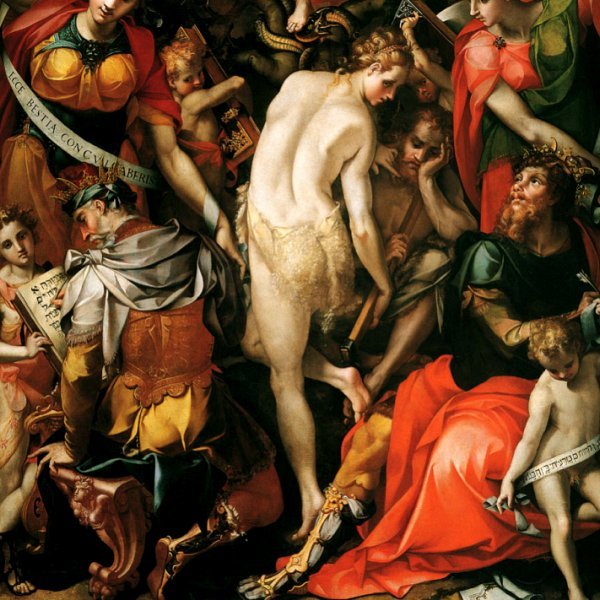Carlo Portelli
Carlo Portelli was an artist interested, until very recently, by a poor critical fortune, indeed, some of his works were completely crushed by critics.
This is the case of the Immaculate Conception today at the Gallerie dell’Accademia in Florence, about which Raffaello Borghini, towards the end of the sixteenth century, moved heavily, as an example of indecorous art.
While the sources agree in indicating Loro Ciuffenna as the birthplace of ours, there are however no certain documents, just as the date of birth is unknown, probably to be placed between the end of the fifteenth century and the beginning of the sixteenth century.
He spent his pupil in Florence, in the workshop of Ridolfo del Ghirlandaio (as Giorgio Vasari recalls) and where, in 1537, he enrolled in the Compagnia di San Luca (or of the Painters), receiving his first official assignment just two years later for Palazzo Medici, on the occasion of the wedding between Cosimo I and Eleonora di Toledo.
In the Florence of the time, Porteli was to enjoy a fair reputation if, from its foundation in 1563, it was accepted into the newly formed Academy of Arts and Design, where he remained there until his death; even Vasari himself indicates him among the “mature” painters and on whom he can certainly rely for his collaboration in the creation of the ephemeral apparatuses on the occasion of the marriage between Francesco I de ‘Medici and Giovanna d’Austria.

Fundamental to free his personal style was the frequentation of the Roman goldsmith Pierpaolo Galeotti, who moved to the Tuscan capital and later his brother-in-law; he had just returned from France, from which he had brought engravings derived from the inventions of Rosso Fiorentino.
This new “way” strongly influenced Portelli, who abandoned the more academic Florentine models, in favor of a painting characterized by more elongated physiognomies and twisted postures, a bright and iridescent palette, almost acidic.
His whole production is characterized by a continuous research and evolution that tries to mediate between the training models and the new stylistic features of fashion painting, trying at the same time to adapt to the new conceptual and spiritual needs of the Counter-Reformation. Among the most important works that mark this turning point is The martyrdom of St. Romulus, signed and dated 1577, for the church of the Cestello, today Maria Maddalena de ‘Pazzi.

In reality, Portelli’s peculiar style can already be felt in the mid-fifties, years in which the first dated works were created and which show a clear bronze influence, especially by revealing a clear understanding of his abstract refinement and the firmness of forms. This is the case of the Madonna and Child with Saint John of Villefranche-sur-Saône, of the Holy Family with Saint John of a private collection or of the Allegory of Charity of Arezzo.
As you can well understand, it therefore appears difficult to move in its production and in the dating of the same, in a continuous change of one’s very personal way. However, it is the study of purely religious works (which constitute the most conspicuous nucleus of our corpus), the most documented ones, that allows us to get closer to the knowledge of this artist, perhaps still little understood today. The first commissions that consecrated his contemporary fortune and that made up most of his pictorial career were precisely the public religious ones, starting from the early 1940s.
Already in the very first works, among which the altarpiece of the main altar of the parish church of Santa Cecilia a Decimo,
representing the Madonna and Child with San Lorenzo and Santa Cecilia, is certainly noticeable, the influences of the most important artists of the time are noted, such as Raffaello and Andrea del Sarto. But the break made by the innovations of Rosso Fiorentino’s art is already clear which, as we have already said, strongly influenced the production of Portelli several times, especially in the acid palette used.
In addition to the chromatic derivation, the art of Rosso became well known to ours thanks to the ultramontane engravings derived from his works, models that can be identified above all in the 1960s. Among these there is certainly the figure of Eve in the Allegory of the Immaculate Conception of ours, whose sinuous posture and the position with the back to the observer is clearly a derivation from The Three Fates of a print attributed to René Boyvin and taken from Rosso Florentine. This altarpiece, dated 1566, perhaps marks the pinnacle of Portello’s production, at the same time causing its critical misfortune not many decades later, when Borghini described Eve as a “great naked sissy showing all the parts behind her”.


The work is in fact characterized by an initial feeling of horror vacui, behind which, however, there is a careful compositional skill with the studied contrast of bodies and chromatic juxtaposition.
In the continuous research and artistic evolution of ours, the final phase is therefore characterized by an accentuation, almost an extremization,
through the creation of twisted compositions that will be worth so much the criticisms of his contemporaries and subsequent criticism, leading to the poor fortune of an artist exponent of the Tuscan way.
He died on 13 October 1574 with great honors bestowed on him by the Academy to which he belonged.




